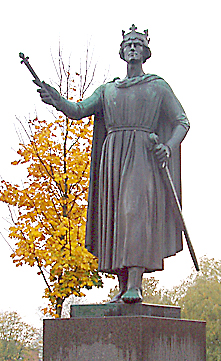Valdemar I of Denmark
| Valdemar I | |||||
|---|---|---|---|---|---|
St. Bendt's Church, Ringsted, Denmark | |||||
| Consort | Sophia of Minsk | ||||
| Issue Detail |
| ||||
| |||||
Estridsen | |||||
| Father | Canute Lavard, Duke of Schleswig | ||||
| Mother | Ingeborg of Kiev | ||||
Valdemar I Knudsen (14 January 1131 – 12 May 1182), also known as Valdemar the Great (

Childhood
Valdemar was the son of
Valdemar was raised at Ringsted in the court of Danish nobleman Asser Rig of Fjenneslev (c. 1080–1151). Asser was a member of the Hvide noble family and had been raised together with Valdemar's father Canute Lavard. Valdemar was raised together with Asser's sons, including Absalon (c. 1128–1201), who would become an archbishop and go to battle with Valdemar, and Esbern Snare (1127–1204), who was a royal chancellor and crusader. Esbern and Absalon had a close relationship and formed an alliance with Valdemar.[2][3][4][5]
Struggle for the throne
In 1146, when Valdemar was fifteen years old, King
Canute was killed at the Bloodfeast of Roskilde in August 1157. Sweyn was defeated by Valdemar in the Battle of Grathe Heath (Slaget på Grathe Hede) on 23 October 1157. Sweyn was killed during flight, supposedly by a group of peasants who stumbled upon him as he was fleeing from the battlefield. Valdemar, having outlived all his rival pretenders, became the sole king of Denmark.[6][7]
Sole reign
In 1158, Absalon was elected
At Absalon's instigation, he declared war upon the
In 1180, as unrest spread throughout the rich province of
Issue
Valdemar married Sophia of Minsk (c. 1141–1198), the daughter of Richeza of Poland, dowager queen of Sweden, from her marriage to Prince Volodar of Minsk. She was the half-sister of King Canute V of Denmark. Valdemar and Sophia had the following children:
- Sophia (1159–1208), married Siegfried III, Count of Weimar-Orlamünde.
- Canute VI of Denmark (1163–1202)
- Maria (born c. 1165), became a nun at Roskilde (1188).
- Margaret (c. 1167 – c. 1205), became a nun at Roskilde (1188).
- Valdemar II of Denmark (1170–1241)
- Ingeborg (1174–1237), married King Philip II of France.
- William, Duke of Brunswick-Lüneburg.
- Richeza (c.1178 – 1220), married King Eric X of Sweden.
- Walburgis (d. 1177), married Bogusław I, Duke of Pomerania.
After Valdemar's death, Sophia married Landgrave
Notes
- ^ "Valdemar Den Store 1131–1182". Danmarks Historien. Archived from the original on 5 July 2011. Retrieved 1 August 2018.
- ^ "Asser (Rig), 1151". Dansk biografisk Lexikon. Retrieved 1 August 2018.
- ^ "Asser Rig". Den Store Danske, Gyldendal. Retrieved 1 August 2018.
- ^ "Absalon". Den Store Danske, Gyldendal. Retrieved 1 August 2018.
- ISBN 978-87-7934-007-7.
- ^ "Blood Feast of Roskilde". The Post Grad Chronicles. 2 December 2017. Retrieved 1 August 2020.
- ^ "Slaget på Grathe Hede 1157". Danmarks Historien. Retrieved 1 August 2018.
- ^ Otto Norn, Jørgen Paulsen and Jørgen Slettebo, Sønderborg Slot. Historie og bygning, G.E.C. Gad forlag, 1963.
- ^ "Sønderborg Castle". kongeligeslotte.dk. Retrieved 1 August 2018.
- OCLC 1350957.
- OCLC 1350957.
- ^ About Vordingborg Castle (Museerne.dk)
- ^ Pratt, Fletcher (1950). The Third King. New York: William Sloane Associates, Inc. pp. 130–131.
External links
 Media related to Valdemar I of Denmark at Wikimedia Commons
Media related to Valdemar I of Denmark at Wikimedia Commons- Valdemar den Store Kings of Denmark, DK
- Bain, Robert Nisbet (1911). . Encyclopædia Britannica. Vol. 27 (11th ed.). pp. 840–841.

